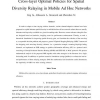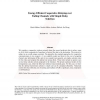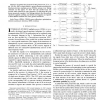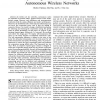TWC
2008
13 years 11 months ago
2008
Using relays in wireless networks can potentially lead to significant capacity increases. However, within an asynchronous multi-user communication setting, relaying might cause mor...
TWC
2008
13 years 11 months ago
2008
In this paper, designing an effective user relaying algorithm, in terms of relay node selection and power allocation, is discussed for amplify-and-forward wireless relay networks. ...
TWC
2008
13 years 11 months ago
2008
Abstract-- This work proposes a novel fault-tolerant classification system based on distributed detection and two-dimensional channel coding. A rule is then derived to reduce the s...
TWC
2008
13 years 11 months ago
2008
This paper analyzes distributed asynchronous power and rate control for wireless ad hoc networks. Importantly, all network transmitters are considered to be independent of any mana...
TWC
2008
13 years 11 months ago
2008
In order to adapt to time-varying wireless channels, various channel-adaptive schemes have been proposed to exploit inherent spatial diversity in mobile/wireless ad hoc networks w...
TWC
2008
13 years 11 months ago
2008
We consider a cooperative wireless network where the source broadcasts data to relays, some or all of which cooperatively beamform to forward the data to the destination. The netw...
TWC
2008
13 years 11 months ago
2008
A method was proposed in this journal (vol. 6, no. 1, pp. 192-201, 2007), which tackles a power allocation problem for interleave-division multiple-access (IDMA) systems over fadin...
TWC
2008
13 years 11 months ago
2008
1 . Cooperative transmission has emerged as an effective tool to deal with channel impairments. In this work we study the applicability of amplify-and-forward cooperative transmiss...
TWC
2008
13 years 11 months ago
2008
In wireless ad hoc networks, autonomous nodes are reluctant to forward others' packets because of the nodes' limited energy. However, such selfishness and noncooperation ...
TWC
2008
13 years 11 months ago
2008
Abstract-- In distributed wireless networks without centralized control, each user is its own authority to maximize its own performance. This distributed characteristic provides th...




